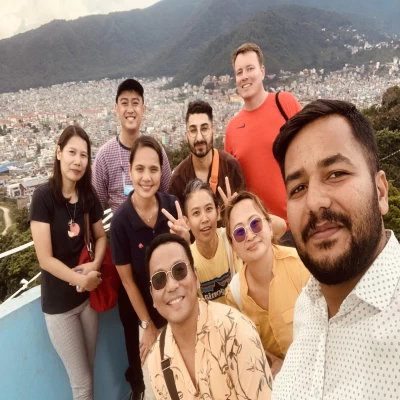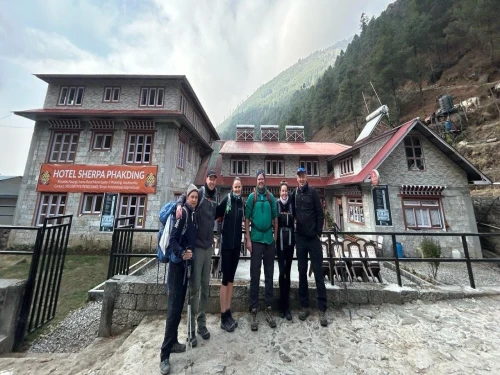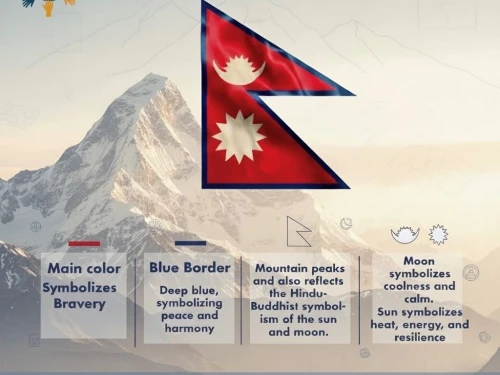How long does it take to climb Mount Everest?
Everest is the highest mountain in the world, at 8848.86 meters above sea level. It is located inside the Mahalangur phase of the Himalayas. Its peak starts from the Everest base camp of the Khumbu Glacier at an altitude of 5316 meters and ends on the southwestern ridge. There are two primary mountaineering routes, one approaching the summit from the southeast in Nepal and the other from the north in Tibet. Its tallest peak not only sends out exceptional views but additionally affords wonderful demanding situations for folks who dare to climb it.
The time required to climb Everest varies, however typically, it takes around 60 to 65 days to complete the whole adventure. The journey begins in late March or early April when climbers arrive in Nepal and trek to the Everest base camp, which takes around 8-10 days. the journey starts in Kathmandu, Nepal, where climbers secure their permits and finalize their preparations before flying to Lukla, the gateway to the Everest region.
From Lukla to Everest Base Camp Trek through River, Thamserku Himal, Everest National Park, Sherpa capital Namche Bazaar, Tengboche, Nuptse, Ama Dablam, etc. You can enjoy panoramic views of the Himalayan range at Kalapathar (5545m) for a four to five-day trek. You can rest for a while and take as many photos as you can.
Acclimatization is essential to the climber before trekking Mount Everest, so, this time is required largely because our body needs to adapt to and adjust in high altitudes where the air is very thin. It is crucial to acclimatization to decrease the risks of high-altitude sickness in the higher areas. For this reason, climbers follow a typical pattern before climbing.
The Everest base camp is situated at around 5300 meters. Usually, you need 4-5 days at the base camp for acclimatization before you climb the Khumbu icefall. After climbing the Khumbu region, climbers return to the base camp for rest.
Climbers stay two nights between Camp I (6,060 m)and return to Base Camp. Again, Climbers Walk to Camp 1 and continue the journey to Camp 2 (6,490 m)before returning to base camp. This is a favorable period at high altitudes in the Everest region. This process makes climbing faster than ever. This process continues for several weeks before the trekkers begin their journey to the summit of Mount Everest.
The last ascent, which begins at Camp IV, located at 8,000 meters, marks the entry to the Death Zone, where the oxygen level is too low to sustain human life for a long time. The climb to the summit of Everest from here on is a long walk to the summit and back to Camp IV, often taking more than 10 hours up and 7 hours down to Camp IV for the night. After one more stop at Camp II, the return reaches Everest Base Camp.
The ambient period is the most important and most time-consuming campaign. To maintain energy, you need to rest on a different campus without your head down constantly. The North Ridge Route is another technically challenging route due to the rocky path.
Difficulties during climbing Mount Everest
The Mount Everest is difficult to climb without training and preparation. Mount Everest requires extensive training at least six months before the expedition. The Mount Everest is considered to be a complicated and challenging endeavor. The altitude and weather conditions make the Everest climb difficult, even for experienced mountaineers. Due to its higher altitude, unpredictable weather, and treacherous terrain, only a few climbers have successfully reached the summit of Mount Everest.
Altitude sickness
Altitude sickness is the biggest risk to Mount Everest climbers. This might affect many aspects of your health. You can feel less oxygen in the air as you reach a higher altitude. Your body can slowly adapt to this but only up to a part.
When you walk for a long time, you are unlikely to feel above the base camp. At altitudes above 8,000 meters, they are beyond the limits of altitudinal adaptability. The most important of these steps is to ascend at a steady pace and take a rest during the acclimatization days in the base camp.
Weather and Temperature
The weather in the Mount Everest region is unpredictable. Climbers are prepared and research how and when it can change the weather in the higher area. The climate and temperature amid your Everest base camp journey will shift altogether depending on the month you select for the expedition.
In Everest, the temperature drops by roughly 0.65c per 100 meters of higher gain. The temperature is about 57 degrees Celsius less than at sea level. It is freezing in the upper area, and trekkers need to prepare for cold situations. So, it would be best to be very careful before the climb. There is a high chance that you will fall sick during the climb.
Why do climbers need to acclimate when climbing Mount Everest?
Acclimatization is the most important in Mount Everest climbing. During the climb, the Mount Everest human body cannot get sufficient oxygen in the higher regions. When you go on ascent in Everest your heart rate increases, you have to breathe faster and faster, and eventually, even walking becomes tiring. A climber's blood vessels are strong enough to cope with the lack of oxygen, but as much blood is being pumped through the body, it is starved of oxygen.
The usual symptoms of high altitude are headache, dizziness, trouble sleeping at night or frequent waking, and weakness. If you get similar symptoms above, don’t go any higher on the mountain or you can go lower for a rest until your symptoms go away. You can move to a higher altitude you can do proper acclimatization in the per camp.
Best season
Mount Everest, standing tall as the highest peak in the world, offers a formidable challenge for climbers. Choose the right season for an ascent crucial for success and safety. The Best time to climb Mount Everest is an important consideration for adventurers aiming to summit this renowned peak.
Spring season
Spring is widely regarded as the best time for a Mount Everest expedition. During this time, the weather starts to warm up, and the harsh winter conditions start to subside. The suitable climate patterns in spring bring clear skies and reduced wind speeds, providing perfect visibility for climbers.
The weather is generally stable, and temperatures are relatively warmer. Climbing usually begins in April, with summits often taking place in late May, just before the monsoon season starts.
Autumn season
Autumn is another perfect season for climbing Mount Everest. This season is also known as the post-monsoon season. This season's weather is generally clean; however, the temperatures are chillier than in spring, and there is regularly extra snow at the mountain. This weather begins in late September and ends in November.
The weather is clear the temperature is warm, and the cloudless sky gives clear picturesque landscapes. The autumn season is the second-best time to climb Mount Everest.
Spring is the optimal season due to better weather and more stable climbing conditions, but fall is also an option for those looking for a quieter experience.
In the Everest Region, winter brings extreme cold, and dry conditions, making climbing difficult, while in the summer season, milder temperatures but heavy rain, and cloud cover, create challenging and slippery trail conditions. Each season has distinct challenges that significantly impact trekking and mountain climbing.
How much does it cost to climb Mount Everest in 2024 & 2025?
The cost of climbing Mount Everest in 2024 & 2025 depends on many factors, such as the choice of expedition company, the level of support required, and personal preferences. On average, most people pay between $40,000 and $60,000, and some pay as much as $160,000 but the price rises each day. The cost typically consists of the most essential expenses along with climbing permits, guide services, and base camp support.
Over the last ten years, companies with Western guides on the Nepal side have increased their average prices from $64,000 to $72,000 today, while Nepal guides have gone from $34,000 to $45,000 but discounted up to 25%. On the Tibet side, the fee for a Western guided trip is still higher at $45,000 to $70,000, while Nepalese guided trips are still in the region of $30,000.In addition, Everest climbing requires considerable money, however, climbers can choose from a wide range, like a personal sherpa, tips, western guides, tents, luxurious meals, etc.
Altogether, the total cost of climbing Mount Everest in 2024 & 2025 can range from $60,000 to over $120,000, making it crucial for climbers to plan carefully and choose reputable expedition providers to ensure each safety and achievement on the mountain.
Various Phases Required for Mt. Everest Expedition
The total days of the whole journey to Mount Everest are between 7 to 11 weeks depending upon the crafted itinerary, equipment, support crew, and climbers.
First Phase
This phase includes pre-campaign preparations and a trek to the base camp, which takes about 10-14 days. Climbers arrive in Kathmandu for a briefing, equipment check, and permit before flying to Lukla. From Lukla, a few days’ treks through the Khumbu area facilitate the climate change, passing through villages including Namche Bazar, Tengboche, and Dingboche before, in the end, accomplishing Everest Base Camp (5,364m).
Second Phase
The second phase, lasting three to five weeks, specializes in acclimatization and rotations between camps. Climbers spend time adjusting to excessive altitudes with acclimatization hikes and rotations through the Khumbu Icefall to Camp 1 (6,065m), Camp 2 (6,400m), and ultimately, Camp 3 (7,300m) on the Lhotse Face, returning to Base Camp between every push to relaxation and recover.
Third Phase
The third phase is the summit push, taking 4-7 days. After final preparations and climate monitoring, climbers move to Camp 3, then to Camp 4 (7,920m) on the South Col, the last staging factor earlier than the summit strives. The summit push usually starts around midnight from Camp 4, aiming to reach the top (8,848.86 m) and return to Camp 4 the same day.
Fourth Phase
The final phase is the descent from Mount Everest and return to Kathmandu, taking about 7-10 days. Climbers descend back from Camp 4 to Base Camp, then retrace their steps to Lukla, where they fly back to Kathmandu. Post-expedition recovery includes relaxation, health checks, and celebrating Mount Everest's successful climb. This structured approach ensures proper acclimatization, minimizes risks, and provides satisfactory risk for a successful summit.
Highlights of climbing Mount Everest
- Climbing Everest offers the opportunity to immerse yourself in Sherpa tradition and interact with local communities.
- The climb offers views of the Panoramic scenery of the mountains, consisting of a number of the highest peaks.
- The biggest monastery within the Everest location, Tengboche Monastery gives picturesque scenery of the Himalayas.
- An iconic landmark of the Everest base camp trek, the Khumbu glacier is stated to be home to a yeti.
- The largest gateway Namche Bazaar is the best place for a climber’s daybreak to acclimatize to the higher altitude.
- The Sagarmatha National Park offers a glimpse into the rich culture of the Sherpa community.
- Kala Patthar gives panoramic views of the entire Everest massif, and plenty of hikers enjoy sunrise or sunset views there.
Why is Mount Everest famous in the world?
Mount Everest is famous worldwide because it stands as the tallest mountain on this planet, reaching an awe-inspiring peak of 8848.86 meters. It is also referred to as the “Roof of the World”, it is a photograph of journey, human patience, and attracting climbers.
The first effectively climbed Mount Everest by Tenzing Norgay and Sir Edmund Hillary in 1953 its mythical fame, and nowadays, it remains a coveted purpose for the ones seeking to push their physical and mental limits. The Everest region is known for its natural beauty, including steep valleys, towering cliffs, and glaciers.
Mount Everest is a popular destination for climbers and adventure-seekers, and trekking to Everest base camp is a popular activity. In Mount Everest, scientists look at weather alternatives, water sources, and modifications to plant, insect, flora, and fauna populations within the Everest area.
The Everest location is home to uncommon and endangered species like the snow leopard, red panda, Himalayan black bear, musk deer, and Himalayan wolves. Mount Everest is a symbol of human resilience, determination, and the pursuit of greatness.
Preparations to climb Mount Everest
Climbing Mount Everest is a massive undertaking that requires careful planning, physical preparation, and logistical arrangements. For any venture in life, desire alone is grossly inadequate. Achieving the goal calls for necessary preparations and climbing Mount Everest is no different. Towards this direction, it starts with hiking and backpacking, eventually, for long hours at a go. Here is a comprehensive guide to help you prepare for the climb.
- Physical fitness and training are most important engage in 6 to 12 months of endurance training before climbing.
- Learn technical climbing skills: ice climbing, using crampons, ropes, and ice axes.
- Practice stress management techniques like deep breathing and meditation.
- High altitude training is essential, along with practicing hiking or altitude simulation, to help hikers acclimate to lower oxygen levels.
- Acclimatization is a key component, requiring a carefully planned ascent with gradual increases in altitude and rest days to adapt to the thinning air.
- Mental preparation is important; mountaineers face extreme conditions, stress, and the psychological challenges of climbing at high altitudes.
- Packing high-quality trekking gear like boots, warm clothing, trekking poles, headlamps, water purifiers, and first aid kits with altitude sickness medicine.
- Research a suitable time before climbing Mount Everest because Mount Everest is the most dangerous in the avalanches.
- Avoid alcohol and smoking during the climb, this reduces oxygen in the blood. So that, this is dangerous at higher altitudes.
Few Climbing History of the World's Highest Peak "Mount Everest"
In 2019 Nirmal Purja (NIMS Dai) summited the world's 14 highest peaks in an astonishing 6-month 7-daywindow, But, Kristina Harilla, a Norwegian mountaineer beat Nirmal Purja and climbed 14 peaks above 8000 meters in just 3 months and 1 day under her latest project "She Moves Mountain". Also, Nepalese climber Tenjin (Lama) Sherpa shared the world record for climbing 14 peaks with KristinaSharmila.
Everest man "Kami Rita Sherpa", a Nepali mountain climber and guide, became the first person most ascending to Mount Everest for a record 30 times on 22 May 2024, breaking his record set on 12 May 2024. He is one of many sherpa guides whose expertise andaptitudes are imperative to the safety and victory each year of foreign climbers aspiring to stand on top of the mountain.
The first Nepalese woman Pasang Lamu Sherpa to climb the summit of Mount Everest on the morning of April 22, 1993, she had attempted to climb MountEverest 3 times but she failed, finally, this day she reached the top of the 8,848.86 m peak with 5 sherpas.
Junko Tabei is a Japanese mountaineer, author, and teacher who also climbed Mount Everest in 1975, she was the first woman to reach the summit in the world.
Bear Grylls American army member who climbed Mount Everest in 1998 at the age of 23, became one ofthe youngest people to have climbed Everest, and he hasn't done it again, but he has undertaken some more challenges over the Himalayas, among many others.
As the son of Sheikh Abdullah bin Muhammad bin Ali Thani, sheik Mohammed is a member of the Qatari House of Al Thani as well as the Emirati al-Qasimroyal family, he became the first Qatari to reach the summit of Mount Everest on 22 May 2013. He also climbed the 6812 meters, Ama Dablam on 11 November 2020.


 4 reviews
4 reviews.webp)
.webp)



